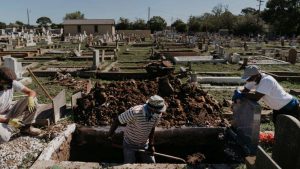MAY 22, 2020

Cemetery workers in New Orleans at the end of April. How deaths are tallied often varies from one state or county to the next.
WASHINGTON, D.C. — President Trump, eager to reopen the economy, has begun questioning the official coronavirus death toll, suggesting the numbers, which have hobbled his approval ratings and harmed his re-election prospects, are inflated.
In coronavirus task force and other White House meetings, conversations with health officials have returned to similar suspicions: that the data compiled by state health departments and the Centers for Disease Control and Prevention include people who have died with the coronavirus but of other conditions. The numbers, some say, include too many “presumed” cases of Covid-19 and too many Americans who were never tested for the disease.
Last Friday, Mr. Trump told reporters that he accepted the current death toll, but that the figures could be “lower than” the official count, which now totals nearly 95,000.
Most statisticians and public health experts say he is wrong; the death toll is probably far higher than what is publicly known. People are dying at their houses and nursing homes without ever being tested, and deaths early this year were likely misidentified as influenza or described only as pneumonia.
Dr. Anthony S. Fauci, the nation’s top infectious disease expert, told lawmakers this month that the overall toll was likely an undercount. “I don’t know exactly what percent higher but almost certainly it is higher,” he said at a Senate health committee hearing.
Jennifer Nuzzo, a senior scholar at the Johns Hopkins Center for Health Security, which is closely tracking the coronavirus pandemic, said that “the officially reported numbers don’t reflect the true level of illness and death that have occurred.”
“We very much feel the reported numbers reflect an undercount,” she said.
Inside the White House, doubts about the official numbers are pervasive, though they come in different forms. Mr. Trump is in search of good news to promote his administration’s response to the pandemic and to press states to reopen. Dr. Deborah L. Birx, the White House’s coronavirus response coordinator, is a numbers obsessive and wants her own data to supplement information coming in from the states and the C.D.C. One official has even accused hospitals of potentially exaggerating their coronavirus patient counts to milk money from Medicare.
Top White House officials have even discussed appointing a “forensic” team to audit how some hospital systems and state health departments have been tallying infections and deaths, according to one senior administration official. Multiple senior White House officials said they were unaware of such conversations.
In a brief interview Thursday, Dr. Birx stressed that there had been no pressure to alter data. “I’ve never been in a meeting where anyone has discussed changing the death numbers,” she said.
And she disputed that the White House was debating the C.D.C.’s counting of probable infections. “There is no tension about their presumed cases,” she said.
But she herself has said publicly that the American health care system incorporates a generous definition of a death caused by Covid-19, the disease caused by the coronavirus.
“In this country we’ve taken a very liberal approach to mortality,” Dr. Birx said at a White House news conference last month. “There are other countries that if you had a pre-existing condition, and let’s say the virus caused you to go to the I.C.U., and then have a heart or kidney problem — some countries are recording that as a heart issue or a kidney issue and not a Covid-19 death.”
Robert Anderson, who runs the mortality statistics branch of the C.D.C.’s National Center for Health Statistics, said the federal government deployed two parallel, related systems to tally deaths, one based on case reports and one on death certificates. He said it was unlikely that there was any kind of overcount.
“The case reporting system asks: Did the patient die from this illness?” he said. “It’s not asking if the patient with Covid-19 died. It’s asking if they died from Covid-19.”
A death certificate, Mr. Anderson said, clearly establishes a cause of death or a contributing factor.
That has not deterred some at the White House to search for new data. Dr. Birx often begins her days before 5 a.m. examining fresh numbers from a small group of Trump administration officials who work late nights in the White House complex.
Detailed to Dr. Birx from the C.D.C., the State Department, the White House budget office and a technology agency called the U.S. Digital Service, the employees compile their own information about the pandemic from state and local health departments in hard-hit parts of the country. That data is then shared with the White House’s coronavirus task force.
White House officials say skepticism in the Trump administration over C.D.C. data, including for opioid use, long predates the coronavirus outbreak. But new reasons have cropped up.
At least one senior White House official has mentioned that hospitals could be inflating their coronavirus patient counts, responding to financial incentives — Medicare offers higher payments to providers for treating coronavirus patients. Several senior officials said they were unaware of such talk.
An official with the American Hospital Association disputed that idea.
“There’s guidance around what you have to do, and the clinician has to say, ‘This is the diagnosis,’” said Nancy Foster, the association’s vice president for quality and patient safety policy. “They’re putting their professional reputation on the line to say that.”
Without doubt, the C.D.C., which collects data from states, has been hampered during the pandemic by inconsistent protocols and limited resources at a local level. How deaths are tallied often varies from one state or county to the next and involves a chaotic mix of health care providers, medical examiners, coroners, funeral homes and local health departments that fill out death certificates, often without official test results.
White House officials have also wanted the C.D.C. to standardize how states report cases to the federal government, a role that now belongs in part to a professional organization, the Council of State and Territorial Epidemiologists.
“There is no organization on earth better at standardizing surveillance than the C.D.C.,” said Dr. Thomas R. Frieden, the agency’s former director. “Could it be better? Absolutely. It could be more timely. It could be more complete.”
Dr. Birx was caught off guard in April when states began incorporating both confirmed and “probable” cases and deaths, senior administration officials said, a change that encouraged a deeper suspicion among those who have doubted the overall mortality figures.
Dr. Birx was again angered by news reports divulging drastic projections she had never seen, the officials said, including those laid out in an internal document obtained by The New York Times that forecast about 200,000 new cases each day by the end of May. The data, which had not been vetted by the White House, came from the Johns Hopkins Bloomberg School of Public Health, which said it was preliminary and should not have been released. It has also proved false.
The Trump administration has looked to the outside to get its numbers. The Department of Health and Human Services has used a technology program devised by Palantir to track numbers gathered by federal agencies, states, private health providers and universities. The administration also signed a $10 million deal with a tracking contractor — first reported by The Washington Post — that monitors hospital capacity and Covid-19 deaths, essentially repeating and privatizing the work of the C.D.C.’s National Healthcare Safety Network.
“If you set up parallel tracks, you will get inconsistent information,” Dr. Frieden said. “You can ask different questions at different times and get different answers.”
Mr. Anderson of the C.D.C. said in an interview that the agency was looking at new systems, including artificial intelligence, to get a better grip on coronavirus trends. “We are in the process of exploring some machine learning and A.I. techniques to try to make the coding more efficient and make the system more nimble,” he said.
Epidemiologists are also rethinking their tabulations, but not in ways the White House would like. They have increasingly compared recent totals of deaths from all causes, which provide a more complete picture of the pandemic’s impact than tracking only deaths of people with confirmed diagnoses. Fatalities in the gap between the observed and normal numbers of deaths are called “excess deaths.” A study of mortality statistics in New York City showed more than 24,000 excess deaths from March 11 to May 2.
Mr. Trump is hardly the only politician uncomfortable with the official coronavirus counts. Jared Polis, Colorado’s liberal Democratic governor, said on “Fox News Sunday” that “the C.D.C. criteria include anybody who has died with Covid-19, but what the people of Colorado and the people of the country want to know is how many people died of Covid-19.”
Last Friday, Colorado’s health department revised its death toll downward, forming two categories to account for what it said were patients who had Covid-19 but died from other causes.
Trying to separate the cause of death in coronavirus-infected patients is “ludicrous,” said Dr. Alicia Skarimbas, a physician in Bergen County, N.J., who has treated around 75 Covid-19 patients.
“I have yet to have anyone infected with Covid die from anything else,” she said.
Courtesy/Source: NY Times









































































































